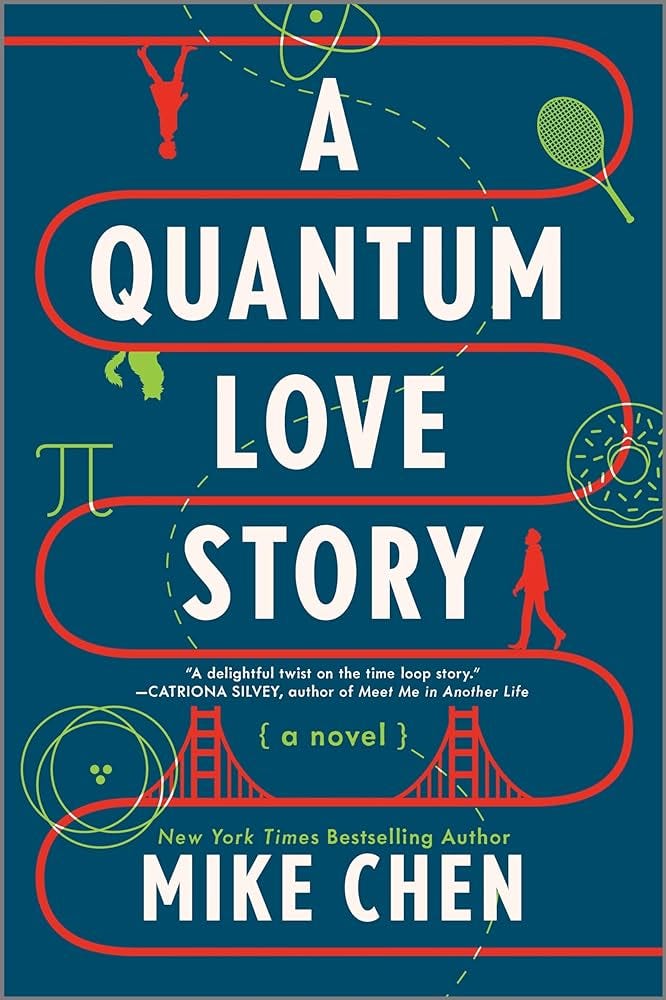Use This Query Template That Led to 4 Agent Offers
Let's apply it to Emily Henry's Funny Story
Here’s what this post includes:
The template Mike Chen used to write a query letter that got him an agent
A breakdown of Mike’s query letter for Here and Now and Then
A workshopped query letter for Emily Henry’s Funny Story (paid subscribers)
A downloadable pdf query template (paid subscribers)
Today I’m sharing a query template created by my friend Mike Chen, author of A Quantum Love Story, which released earlier this year from HarperCollins/Mira.
Mike’s query letter for his debut novel, Here And Now And Then had an amazingly high request rate—of the 90 queries he sent to agents, 18 requested his manuscript, and 4 agents offered to represent him. It’s rare to get a 20% request rate from a query letter, and Mike’s premise and writing style probably helped a lot, but the structure of Mike’s query letter made his pitch especially engaging.
With Mike’s permission, I’m sharing with you his template for writing a query letter. I’ve slightly modified it to include more detailed explanations.
Mike Chen’s Query Template
1. Intro Sentence With Ironic Twist
The opening line states the main conflict with a hint of irony.
2. Back Story and Emotional Conflict
Briefly describe your main character. My own advice is that you might include
a long-standing burden
something the character has been longing for since before the story started
For a novel with two POV’s, you’ll need to do this twice, once for each POV character.
3. Act 1 Catalyst
Introduce the opportunity presented in your opening chapters, the catalyst that will draw your main character into the plot. It might look something like this: “But when ___ happens, [character] must…”
4. Hint at the B-Story
Include a short mention of the secondary plot.
5. Raise the Stakes
Describe how everything goes wrong for your main character without giving away the end of the story. Provide evidence of a “ticking clock.”
6. Final Line: Address the Irony of the Opening Sentence
Revisit the opening line and hint at the end of the story without giving it away.
Query Letter Breakdown: Here and Now and Then
Let’s put all of these steps together, with Mike’s actual query letter for his debut novel. Mike’s analysis is included beneath each section of his query letter text.
1. Intro Sentence With Ironic Twist
Kin Stewart thought parenting a teen couldn’t get any harder, but then he got separated from his daughter—by a century.
Your core conflict here is the relationship between father and daughter. This drives the whole book—how far will a parent go to do right by his child? The twist here, then, is that the separation isn’t what we perceive in our real world of distance (like a job or a divorce takes you away) but by time.
2. Back Story and Emotional Conflict
Before that, he was a normal family man, working and parenting teenage Miranda—a far cry from his old job as a time-traveling secret agent from 2142. Stranded in suburbia since the 1990s because of a botched mission, he’d spent the last 17 years thinking about soccer practices and family vacations instead of temporal fugitives.
Now we have the setup that puts the opening hook into context. In this case, it’s a fish-out-of-water story with a time-travel twist.
3. Act 1 Catalyst
But when his rescue team suddenly arrives, Kin is forced to abandon his family and return to 2142…
The Act 1 catalyst is the arrival of the rescue team—this is the key accelerant in the story; it’s hinted at in Chapter 1 and ramps up in Chapter 2, then drives the story in Chapter 3.
4. Hint at the B-Story
...where everyone—including his fiancée, who’s unaware of time travel—thinks he’s only been gone weeks, not years. Ordered to cut all contact with the past, Kin defies his superiors and attempts to raise his daughter from the future.
The hint of the B-story, which is how Kin tries to balance returning to his family in 2142, provides greater depth while showcasing another side of the conflict.
5. Raise the Stakes
Until one day he discovers that Miranda’s being erased from history...and it might be his fault.
With time running out, Miranda’s very existence depends upon Kin taking a final trip across time, no matter the cost. Break time-travel rules, tell his fiancée about Miranda and his secret family, even put his own life on the line…
Every line here raises the stakes on the previous one: conflict with old family and timeline reconciliation, more conflict with cutting off the past, and more conflict by defying that. Then the All Is Lost moment (Miranda is erased) and the ticking clock that breaks into Act 3.
6. Final Line: Address the Irony of the Opening Sentence
…those are risks Kin will take because there’s only one thing more important than the past and the future: doing right by his daughter.
I always try to have the final line tie into the opening line. Rhythm is a big part of queries, so doing something like this acts as a strong final punchline while giving that whole-circle feel. Thus, we open with Kin struggling to connect with his daughter emotionally and we close with Kin struggling to connect with his daughter physically. It sets a nice balance to the whole piece.
You can find Mike’s original breakdown of his query letter at his website. His new novel, A Quantum Love Story, is about a woman who must find a way to break out of a time loop or lose the man she loves.
Workshopping The Query Letter: Funny Story
Let’s revise the jacket copy from Emily Henry’s Funny Story to create a query letter for the novel, using Mike’s query template. (Mild spoilers ahead.)









